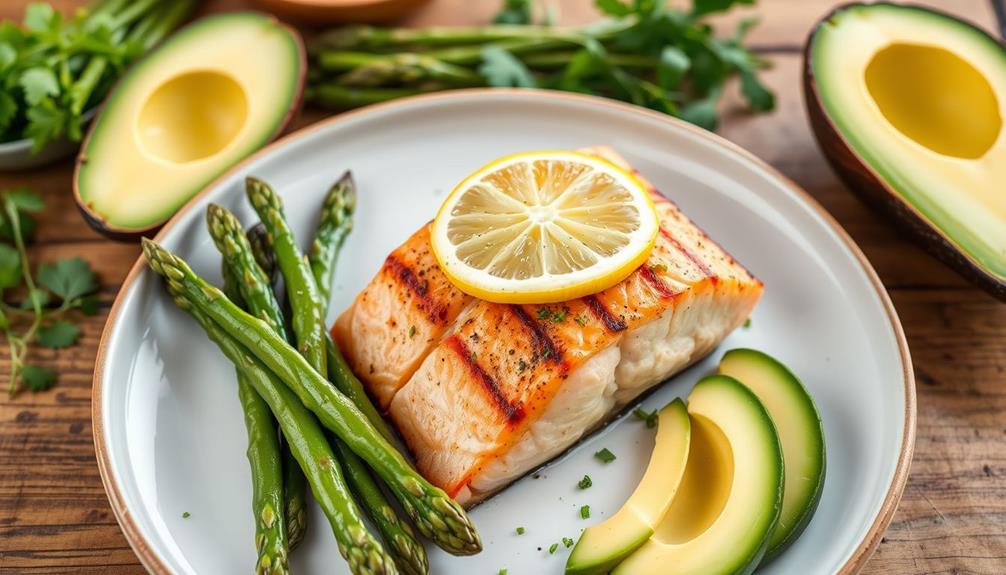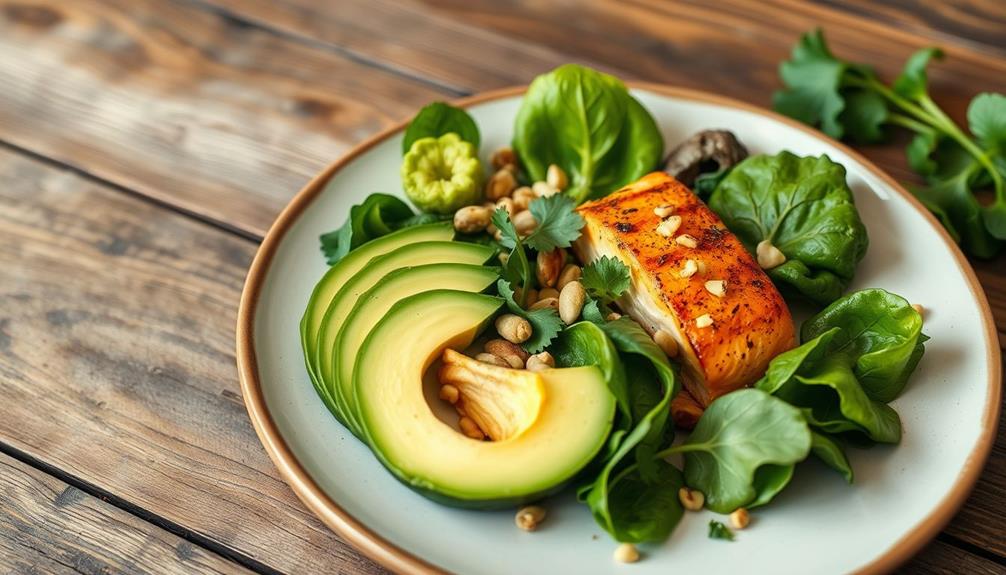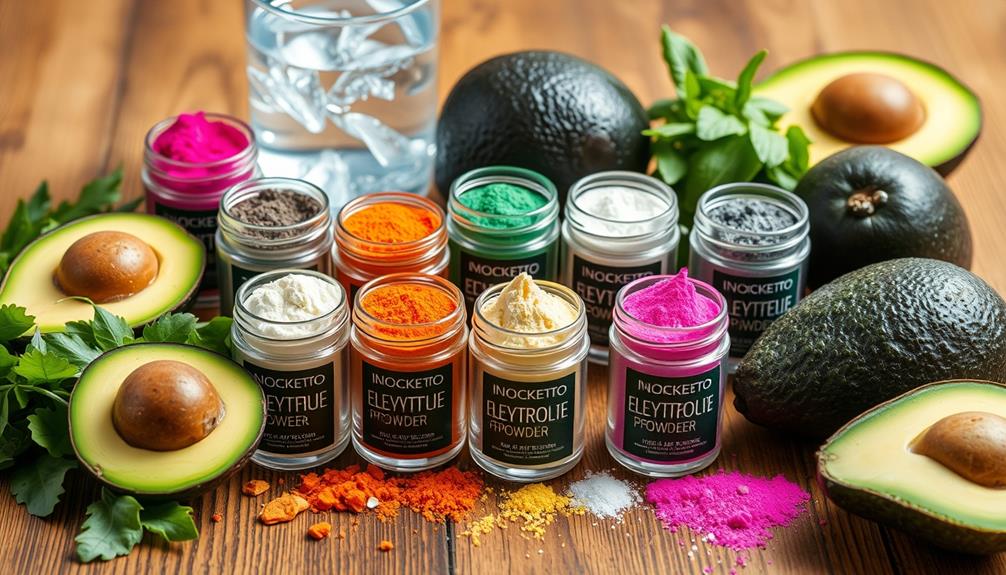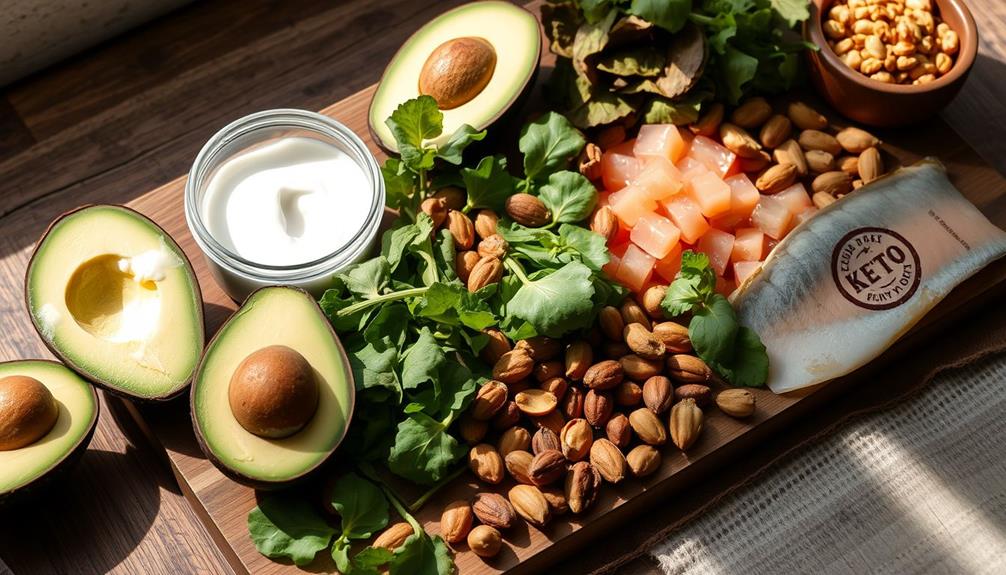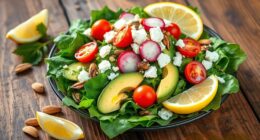On the keto diet, you should limit your carbohydrate intake to 20-50 grams of net carbs per day to maintain ketosis. This means you need to focus on the digestible carbs that impact your blood sugar levels. To help achieve your goal, track your intake using apps or food diaries. Prioritize low-carb foods like non-starchy vegetables and healthy fats, while avoiding high-carb options like grains, sugars, and starchy fruits. Keeping a close eye on your carb count is essential for success. If you're curious about more tips and insights on the keto lifestyle, there's plenty more to discover.
Key Takeaways
- The ketogenic diet typically limits carbohydrate intake to 20-50 grams of net carbs per day to maintain ketosis.
- Net carbs are calculated by subtracting fiber and sugar alcohols from total carbohydrates.
- Aim for a macronutrient ratio of 70-80% fat, 10-20% protein, and 5-10% carbohydrates.
- Regularly track carbohydrate intake using food diaries or apps to avoid hidden carbs in processed foods.
- Consistent monitoring of ketone levels can help determine if you are in ketosis.
Understanding the Keto Diet
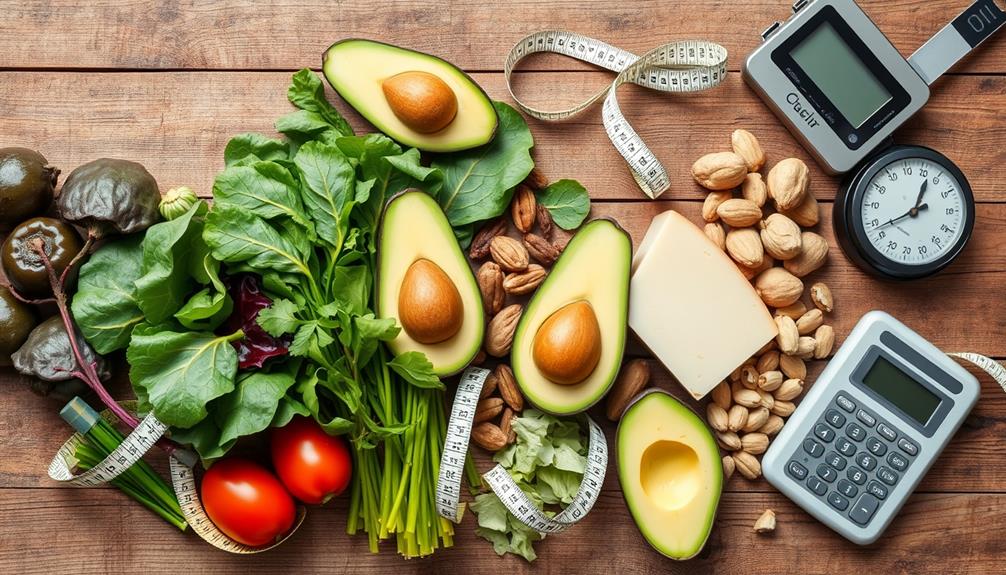
When diving into the ketogenic diet, it's essential to grasp its core principles. The keto diet emphasizes a significant carbohydrate restriction, typically limiting your carb intake to under 50 grams of net carbs per day. This restriction is key to achieving ketosis, a metabolic state where your body shifts to burning fat for fuel instead of carbohydrates.
Additionally, understanding the impact of juice diets on your overall nutrient intake can be beneficial, especially if you're considering incorporating juices while following keto.
Understanding the keto diet involves knowing how to calculate net carbs, which you get by subtracting fiber and sugar alcohols from total carbohydrates. This calculation helps you track your carb intake more accurately.
Generally, to maintain ketosis, you'll aim for a macronutrient ratio of about 70-80% fat, 10-20% protein, and only 5-10% carbohydrates.
You'll want to avoid high-carb foods like grains, sugars, starchy vegetables, and most fruits to stay within your limits. Individual factors such as your weight, fitness level, and metabolic health can also influence the best carbohydrate intake for you.
Carbohydrate Limits on Keto

Carbohydrate limits play a significant role in the success of the ketogenic diet. To achieve ketosis, you'll typically need to limit your carbohydrate intake to 20-50 grams of net carbs per day. Net carbs are calculated by subtracting fiber and sugar alcohols from total carbohydrates, making it essential to track these values accurately for your dietary success.
Additionally, understanding the potential side effects and interactions of various foods can help you make informed choices while following the diet, much like how you'd consider cold medications for effective relief during a cold.
Reducing your carbs per day to below 50 grams prompts your body to burn fat for fuel instead of glucose, which is the goal of the keto diet. However, not all foods are created equal; some may contain hidden carbohydrates, especially processed foods. Staying within limits requires you to be vigilant about what you're eating.
Regular monitoring of your carbohydrate intake is crucial for maintaining ketosis. Many people find it helpful to use food diaries or tracking apps to guarantee compliance with their goals.
The Role of Net Carbs

Net carbs are a critical concept in the ketogenic diet, serving as the key to unfastening and maintaining ketosis. To guarantee you're on track, it's crucial to understand how to calculate net carbs correctly. This is similar to how budgeting is vital for financial health, as both require careful tracking of inputs and outputs.
You'll want to focus on the digestible carbs that impact your blood sugar levels, which means subtracting fiber and certain sugar alcohols from total carbohydrates. Here's how to effectively manage your carbohydrate intake:
- Limit Your Intake: Aim for 20-50 grams of net carbs per day to maintain ketosis.
- Choose Wisely: Prioritize non-starchy vegetables, which are low in net carbs compared to starchy vegetables and fruits.
- Track Your Progress: Use food diaries or apps to track net carbs, guaranteeing you stay within your limits.
Foods to Include on Keto

When you're on the keto diet, focusing on high-fat foods is vital for staying in ketosis. Incorporate healthy fats like avocados, olive oil, and nuts into your meals, while also adding low-carb vegetables like leafy greens and broccoli to keep your nutrient intake balanced.
This combination helps you meet your daily caloric goals and keeps net carbs low. Additionally, it's important to monitor your food choices to guarantee you maintain a balanced diet that supports overall health, as noted in the effective strategies for weight loss.
High-Fat Foods
On the keto diet, embracing high-fat foods is essential for achieving and maintaining ketosis. These foods not only help you stay in a state of ketosis but also provide the necessary nutrients your body craves.
Additionally, understanding the different brewing methods for your coffee can enhance your overall experience while on the diet.
Here are three high-fat foods to include in your diet:
- Fatty Fish: Salmon and mackerel are fantastic sources of omega-3 fats, and they contain about 0 grams of carbs per serving. These healthy fats are vital for heart health and overall well-being.
- Olive Oil: A staple in any high-fat diet, olive oil has around 0 grams of carbs and is rich in heart-healthy fats. Use it for cooking or drizzling over salads for added flavor.
- Full-Fat Dairy: Incorporate cheese and heavy cream into your meals, as most varieties contain less than 1 gram of carbs per ounce. They not only support your high-fat intake but also add richness to your dishes.
Including these nutritious options in your low-carb diet will help you thrive on your ketogenic journey!
Enjoy the delicious flavors while keeping your net carbs per meal in check.
Low-Carb Vegetables
Incorporating low-carb vegetables into your keto diet can enhance your meals while keeping your carbohydrate intake in check. These veggies are essential for maintaining ketosis, with options like spinach containing only 0.4 g net carbs per cup.
Leafy greens, such as kale and Swiss chard, are nutrient-dense, with kale offering around 1 g net carbs per cup when raw. Additionally, using essential oils like peppermint oil can provide invigorating flavors that complement your meals while supporting your overall wellness.
Cruciferous vegetables like broccoli and cauliflower are also excellent choices. Broccoli provides approximately 3.7 g net carbs per cup, while cauliflower serves as a versatile low-carb substitute for grains.
Non-starchy vegetables, including bell peppers (2.9 g net carbs per cup) and zucchini (2.4 g net carbs per cup), can add variety and flavor to your keto meals without exceeding your carb limits.
Incorporating high-fiber low-carb vegetables not only supports digestive health but also helps you stay within your net carb goals. By focusing on these options, you can enjoy a diverse, flavorful diet while effectively maintaining ketosis.
Embrace the power of low-carb vegetables to make your keto journey more enjoyable and successful!
Foods to Avoid on Keto

Avoiding high-carb foods is essential for anyone following the keto diet. Consuming too many carbs can kick you out of ketosis, so it's important to know what to avoid. Here are three categories of foods to steer clear of:
- High-Carb Fruits and Vegetables: Avoid fruits like bananas and starchy vegetables such as sweet potatoes, which contain over 20 grams of net carbs each. Opt for low-carb alternatives instead, and consider exploring various coffee varieties to enhance your diet experience.
- Sugary Drinks: Eliminate sugary drinks such as regular sodas and cocktails like piña coladas. These can exceed 36 grams of sugar or 32 grams of net carbs per serving, sabotaging your diet.
- Grains and Legumes: Foods like bread, pasta, and beans are packed with high carbohydrates. Even whole grains can contain significant amounts of net carbs, so it's best to skip them altogether.
Also, watch out for processed foods, as sauces and dressings may contain hidden carbs that can affect your limits.
Instead of high-carb snacks like potato chips, opt for keto-friendly snacks to maintain your carb count. Stay vigilant, and you'll succeed on your keto journey!
Monitoring Your Carbohydrate Intake
Monitoring your carbohydrate intake is essential for staying in ketosis on the keto diet. To maintain ketosis, you should keep your total carbohydrate intake to less than 50 grams per day. Understanding net carbs—total carbs minus fiber and sugar alcohols—can help you assess your intake accurately.
| Carbohydrate Source | Net Carbs (per serving) |
|---|---|
| Avocado | 2g |
| Almonds | 2g |
| Honey Mustard Sauce | 5g |
Tracking your intake with a food diary or a mobile app can prevent unintentional overconsumption of carbs. Be especially cautious of hidden carbs found in sauces and processed snacks, as these can easily push you over your daily carb limits. Regularly testing your ketone levels with urine strips or blood tests can provide feedback on whether your carbohydrate intake is effectively maintaining ketosis. By being diligent about monitoring your carbohydrate intake, you can enjoy the benefits of the keto diet while staying on track.
Common Mistakes to Avoid
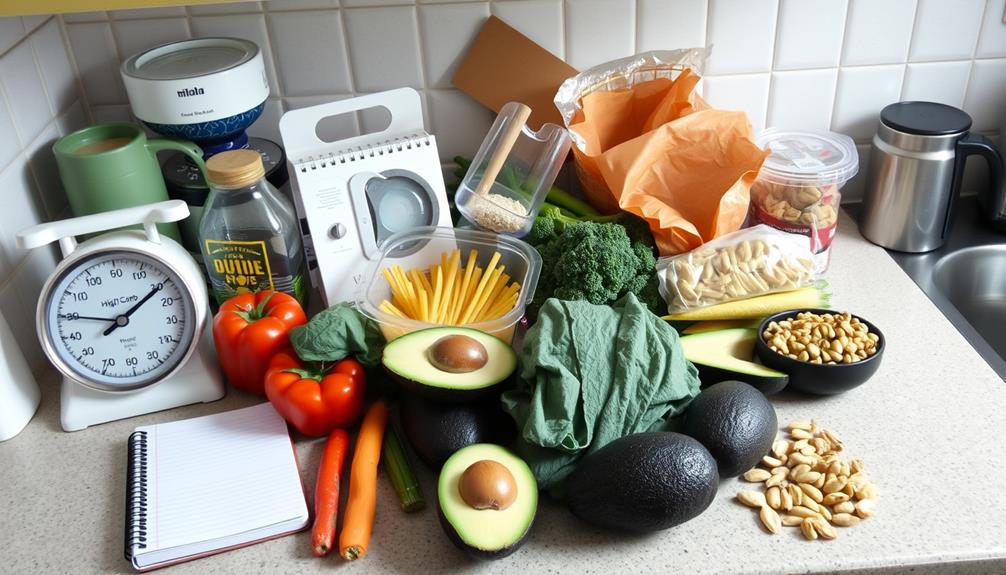
Many new keto dieters make essential mistakes that can derail their progress. To stay on track, watch out for these common pitfalls:
1. Ignoring Hidden Carbs: Processed foods often contain hidden carbs that can sabotage your efforts. Always read labels carefully and track every source of carbs you consume.
Additionally, it's beneficial to stay updated on free crypto opportunities that can help fund your keto journey.
2. Overeating Protein: While protein is vital, too much can kickstart gluconeogenesis, converting protein to glucose and disrupting ketosis. Aim for about 0.7-0.9 grams of protein per pound of body weight to maintain your energy source without derailing your diet.
3. Neglecting Fat Intake: Remember, fat is your primary energy source on keto. Inadequate fat intake prevents you from entering ketosis; aim for 70-80% of your calories from healthy fats.
Additionally, hydration is significant. Failing to drink enough water can lead to symptoms of the "keto flu," like fatigue and irritability.
Don't forget to monitor your net carbohydrates, which you calculate by subtracting fiber and sugar alcohols from total carbs. Keeping your intake within 20-50 grams daily is key to successful keto dieting.
Avoiding these mistakes will help you reach your keto goals.
Health Benefits of Low Carbs

The ketogenic diet offers a range of health benefits that can transform your well-being. By limiting your carbohydrate intake to less than 50 grams per day, you promote fat utilization as your primary energy source, leading to significant weight loss and improved metabolic health.
Research indicates that those on a low carb diet, like the ketogenic diet, experience greater reductions in body fat and triglycerides compared to traditional low-fat diets. Additionally, adopting a low carb diet may help breast cancer symptoms management by improving overall health and wellness, which is vital for individuals at risk.
One of the key health benefits of the ketogenic diet is improved insulin sensitivity. This can be especially beneficial for individuals dealing with type 2 diabetes or insulin resistance.
Additionally, many people notice appetite reduction, making it easier to stick to the diet and manage their weight effectively.
Moreover, a meta-analysis of studies reveals that low-carb diets can lead to favorable changes in cholesterol levels and triglycerides, enhancing overall cardiovascular health.
With these combined advantages, adopting a ketogenic approach can't only support your weight loss goals but also contribute to long-term metabolic health. Embracing a low carb diet may just be the key to achieving a healthier, more vibrant life.
Long-Term Sustainability of Keto

Adopting a ketogenic diet can be an effective strategy for weight loss and improving metabolic health, but you might wonder how sustainable it's in the long run.
Research shows that many people find it manageable due to several key factors:
- High Compliance Rate: With an impressive 88% adherence, many individuals experience significant benefits, including improved insulin sensitivity and weight loss. This high compliance is vital, as sustained dietary changes can positively impact mental health, similar to how ongoing support is essential for individuals with Borderline Personality Disorder.
- Enhanced Energy Levels: After the initial adaptation phase, you may enjoy increased energy, mental clarity, and satiety, making it easier to stick with the diet.
- Flexible Carb Intake: The ability to gradually reintroduce carbohydrates once you've reached your goals allows for a sustainable approach to meal planning.
To guarantee the keto diet remains beneficial, regular monitoring of health parameters, like blood lipid levels, is vital.
Ongoing research into keto variations and resources makes it increasingly accessible.
With the right strategies, you can maintain long-term adherence while enjoying the health benefits that come with this low-carb lifestyle.
Frequently Asked Questions
How Many Carbs Can I Eat and Stay in Ketosis?
To stay in ketosis, you'll need to limit your net carb intake to about 20 to 50 grams daily. Monitoring hidden carbs is essential, as they can easily push you over your limit.
Can You Lose Weight on 50 Carbs a Day?
Yes, you can lose weight on 50 carbs a day. Many people find that this limit helps them feel less hungry and promotes fat burning, leading to significant weight loss over time.
How Many Carbs to Be Kicked Out of Ketosis?
Imagine a tightrope walker balancing carefully. If you exceed 50 grams of carbs daily, you risk tumbling out of ketosis. Your unique body may react differently, so track your intake closely to maintain that balance.
Is 100 Carbs a Day Low Carb?
You might find that 100 grams of carbs daily isn't considered low carb. While it can aid weight loss, it's likely too high to achieve the metabolic benefits of a strictly low-carb approach.
Conclusion
In the world of keto, keeping your carbs low is like steering a ship through narrow waters; you need to navigate carefully to stay on course. By understanding your carb limits and focusing on net carbs, you can make the most of your meals while reaping the health benefits. Remember, it's not just about cutting carbs but finding a balance that works for you. So, grab your compass and set sail toward a healthier lifestyle!

